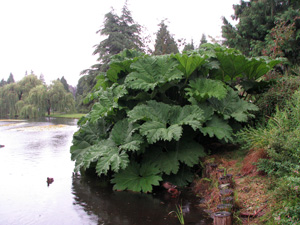Resource Library
Plant of the Week: Gunnera
The University of Arkansas System Division of Agriculture does not promote, support or recommend plants featured in "Plant of the Week." Please consult your local Extension office for plants suitable for your region.
Plant of the Week
Gunnera
Latin: Gunnera manicata

Lust, so we are told, is a bad thing, but sometimes it is hard to help yourself when you see a gorgeous thing you desire but know you can’t have. The first time I saw a magnificent clump of Gunnera manicata growing along a pool in England, I wanted one. I still want one, but even though it is theoretically possible to grow one, I doubt I’ll ever expend the energy to do so.
Gunnera, sometimes called giant rhubarb, is one of about 50 species of equatorial and southern hemisphere herbaceous perennials that belong to their own unique plant family. Many Gunnera are trailing, rhizomatous plants better suited as groundcovers but a few, especially – G. manicata and the slightly smaller G. tinctoria – are clump forming deciduous plants with enormous leaves capable of growing to 5 or 6 feet across that make a bold statement in the garden.
The giant leaves are produced from an elongating crown that can become a couple feet long in a frost-free region. The leaves are palmately arranged with deep lobes and protected on the undersurface and petiole with stiff, sharp spines. Plants typically reach 6 feet in height during the growing season with a spread equal to or greater than their height. As the clumps get better established the size of the leaves increase.
Gunnera produce erect, bottle brush-shaped spikes of tiny brownish flowers that are followed by clusters of red berries if seed set occurs. The flowers are wind pollinated with a mixture of male and female blossoms on each spike. But it is the leaves that make this plant popular in gardens, not the flowers.
G. manicata is native from Columbia to southern Brazil along the cooler, wetter places at the foot of the Andes. It typically grows in high rainfall areas receiving 5 feet or more of rain a year or areas with foggy or misty conditions. G. tinctoria – often the plant sold as the previously mentioned species – is native to the cool, foggy regions of Patagonia and is a considered hardy to zone 7 whereas the more tropical G. manicata is only hardy to zone 8.
Gunnera are often described as dinosaur plants because of their oversized leaves, but there may be some credence to this name. Their unique distribution – Africa, Madagascar, New Zealand, parts of Polynesia, and South America – point to a common ancestor arising sometime before the breakup of the supercontinent Gondwana some 130 million years ago. Fossil records date them as being at least 95 million years old, so undoubtedly they did co-existed with dinosaurs.
But the most unique part of their biology is an intercellular symbiotic relationship with a strain of cyanobacteria, also known as blue-green algae. The cyanobacteria are taken in through specialized glands at the base of the leaf and transported to spaces between the plant’s cells in the leaves where they fix atmospheric nitrogen. In turn the cyanobacteria receive carbohydrates from the plants. This symbiosis points to the likelihood that Gunnera evolved from aquatic plants that are still figuring out how to grow on dry land.
The easiest way to grow Gunnera is to relocate to the Pacific Northwest or perhaps coastal areas of Scotland. In those cool, moist, almost frost-free regions Gunnera find a home most to their liking. They are best planted along standing or running water where the plants will soak up abundant summertime moisture. However, in the winter excess water and cold temperatures cause rot. Some gardens go so far as to lower the wintertime water level of their ponds to reduce the likelihood of rotting roots.
Preventing rotting roots is only half the battle. To protect from freezing conditions successful gardeners turn a wooden basket over the crown after removing the leaves. Then they mulch the basket with dry leaves to sufficient depth to ensure the ground does not freeze. The leaves are removed when the worst of winter is past but the basket remains in place until the possibility of frost has passed. All this sounds like a lot of trouble, but you would be a horticultural superstar if you could successfully grow one of these beauties in your garden.
By: Gerald Klingaman, retired
Retired Extension Horticulturist - Ornamentals
Extension News - January 4, 2013
The University of Arkansas System Division of Agriculture does not maintain lists of retail outlets where these plants can be purchased. Please check your local nursery or other retail outlets to ask about the availability of these plants for your growing area.